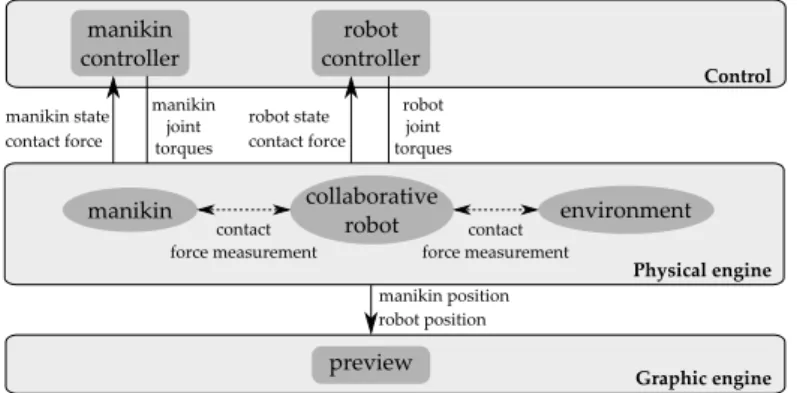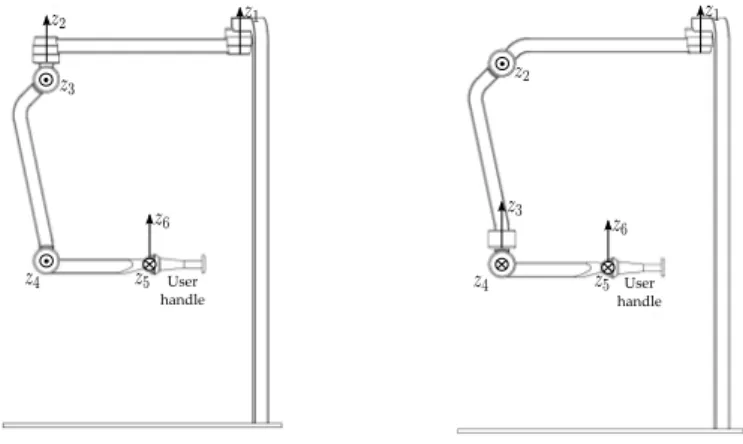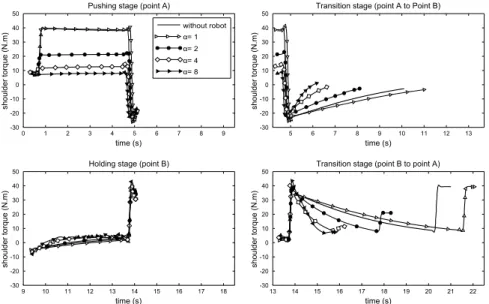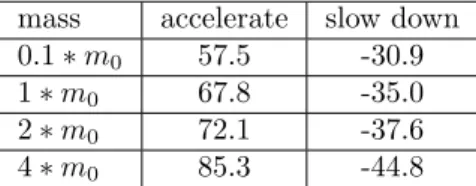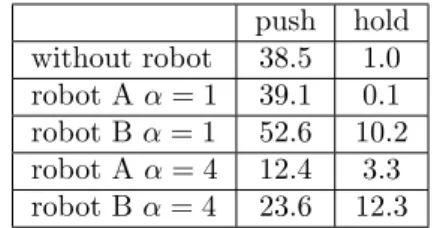HAL Id: hal-00720750
https://hal.archives-ouvertes.fr/hal-00720750
Submitted on 25 Jul 2012
HAL is a multi-disciplinary open access
archive for the deposit and dissemination of
sci-L’archive ouverte pluridisciplinaire HAL, est
destinée au dépôt et à la diffusion de documents
Assessment of physical exposure to musculoskeletal risks
in collaborative robotics using dynamic simulation
Pauline Maurice, Yvan Measson, Vincent Padois, Philippe Bidaud
To cite this version:
Pauline Maurice, Yvan Measson, Vincent Padois, Philippe Bidaud. Assessment of physical exposure to
musculoskeletal risks in collaborative robotics using dynamic simulation. Bidaud, Philippe and Khatib,
Oussama and Padois, Vincent. 19th CISM-IFToMM Symposium on Robot Design, Dynamics, and
Control - RoManSy, Springer, To appear, 2012, CISM Courses and Lectures. �hal-00720750�
Assessment of Physical Exposure to
Musculoskeletal Risks in Collaborative
Robotics Using Dynamic Simulation
Pauline Maurice* and Yvan Measson*and Vincent Padois† and Philippe
Bidaud†
* CEA LIST, Fontenay-aux-Roses, France †
ISIR, University Pierre and Marie Curie, Paris, France Abstract Many industrial tasks cannot be executed by a robot alone. A way to help workers in order to decrease the risk of mus-culoskeletal disorders is to assist them with a collaborative robot. Yet assessing its usefulness to the worker remains costly because it usually requires a prototype. We propose a dynamic simulation framework to model the performing of a task jointly by a virtual manikin and a robot. It allows to measure physical quantities in or-der to perform an ergonomic assessment of the robot. Experiments are carried out on two different robots. The results show that the proposed simulation framework is helpful for designing collaborative robots. Further work includes enhancing the simulation realism and validation on a real robot.
1
Introduction
Though working conditions have improved in developed countries, work-related musculoskeletal disorders (MSD) remain a major health problem. These disorders affect the body’s muscles, joints, tendons, ligaments and nerves. They result from strenuous biomechanical solicitations caused by physical work. According to several studies (Silverstein and Adams, 2005, and Jones et al., 2005), over 50% of workers in industry suffer from MSD. In France it represents about 80% of the occupational diseases in 2009 (Ha and Roquelaure, 2010). Indeed, despite the growing robotization in indus-try, many hard tasks cannot be fully automatized, because of their unpre-dictability or their technicality. A solution is to assist the worker with a collaborative robot (or intelligent assist device), rather than replacing him. A collaborative robot enables the joint manipulation of objects with the worker and thereby provides a variety of benefits such as strength amplifi-cation, inertia masking and guidance via virtual surfaces and paths (Colgate et al., 2003).
The purpose of these collaborative robots is to decrease the risk of MSD by alleviating the worker’s physical load and improving his posture. One of the main issues in the design process of a collaborative robot is to take into account the human presence and capabilities. Yet performing an er-gonomic assessment of such a robot is essential to check its usefulness to the worker. Many methods exist (Guangyan and Buckle, 1999), based on the observation of an actual worker, but they need a prototype of the robot. It is a significant limitation in terms of cost and time. An alternative is to perform the assessment within a digital world, using a virtual manikin to simulate the worker. Digital human models are already available to evaluate the design of workstations, such as JACK, RAMSIS, SAFEWORK or SAM-MIE (Blanchonette, 2010, and Porter et al., 2004). But they do not allow a fully automatic and dynamic simulation of realistic movements. Moreover, the commercial software frameworks in which these manikins are integrated were not designed with collaborative robotics in mind.
We propose a method based on a dynamic simulation framework includ-ing a digital manikin, to estimate a priori the biomechanical benefit of a collaborative robot. This framework has already been used for a work task ergonomic assessment in De Magistris et al. (2011). Our contribution re-gards the addition of a collaborative robot interacting with the manikin, so that they perform the task jointly. Section 2 describes the simulation framework and the test case. Section 3 details the results and discusses their relevance towards the MSD risk assessment. Section 4 presents the conclusions and perspectives of this study.
2
Materials and Methods
The purpose of the simulation is to have a virtual manikin automatically perform a given work task, with and without the help of a collaborative robot, in order to measure biomechanical quantities (see Figure 1 for the description of the simulation framework). The manikin is described in Sec-tion 2.1, the robot and the task in SecSec-tion 2.2 and SecSec-tion 2.3.
2.1 Virtual Manikin
The human body is modelled kinematically as an arborescence of rigid bodies linked by hinge joints. The actuation model is articular (there is no muscle model) and the root is not controlled.
By modifying the worker’s efforts needed to perform the task, the use of a collaborative robot affects the worker’s posture. So data from real workers cannot be used to control the manikin. The manikin posture is
Control manikin joint torques robot joint torques robot state contact force manikin state contact force manikin controller robot controller Physical engine manikin collaborative robot environment contact contact force measurement force measurement
manikin position robot position
Graphic engine
preview
Figure 1. Description of the simulation framework.
generated at each time step thanks to a multi-objective optimization with a force control approach based on a quadratic programming problem and a Jacobian transpose control method proposed by Liu et al. (2011). The different objectives are :
• Center of mass: the horizontal position of the CoM is controlled to maintain the manikin balance. The CoM vertical position is controlled to keep the manikin upright.
• Contact forces: to produce stable motion with smaller contact forces, one of the objectives is to minimize the contact forces between the feet and the ground.
• Manipulation task: the position and orientation of the right hand are controlled to follow a trajectory depending on the task. The contact forces on the hand can also be controlled to match a reference effort. • Visibility: the orientation of the head is controlled to direct the face
of the worker towards the work zone.
• Posture: a secondary articular objective is added because of the re-dundancy of the human body. The manikin posture should be as close as possible to the one of a man resting upright.
2.2 Collaborative Robot
The robot was designed by the CEA and the RB3D company to help workers in manual tasks which require the application of significant efforts via a portable tool. It provides strength amplification (Kazerooni, 1990). The robot A is a serial chain with 6 hinge joints (see Figure 2 left). The tool is attached to the tip of the end effector and the robot is manipulated by the worker via a handle fixed on the end effector. Another version (robot B)
of this robot was also tested as a comparison. Two joint axes are inverted, and some segments lengths are modified (see Figure 2 right).
User handle
User handle
Figure 2. Kinematic architecture of collaborative robots A (left) and B (right).
The control of the robot consists in compensating for gravity and dry and viscous friction, and amplifying the efforts of the worker. The force applied on the tool is equal to the one applied by the worker multiplied by a coefficient α. A force sensor on the user handle allows the force measure-ment. The real control framework is simplified since there is no actuator model (one controls directly the joint torques) and the dry friction is not yet implemented in the physical engine of the simulation (see Figure 3).
2.3 Task
The purpose of these first tests is more to validate the assessment method than to evaluate a collaborative robot. So a simple task was chosen. The manikin moves the tool back and forth between point A and point B, and stays 4s on each point. Point A is located on the surface of a fixed rigid body. There the normal contact force must be kept to a stable value (80N ± 5%). Point B is 10cm backwards.
3
Results and Discussion
The main biomechanical risk factors for MSD are extreme postures, con-siderable efforts, high frequency of the gestures and static work. Therefore we are particular interested in the joints angles and torques. The shoulder
Dynamic simulation Joint torques Robot state Contact force with manikin
Figure 3. Block diagram of the robot control framework. movement A B manikin robot rigid body
Figure 4. Screenshot of the sim-ulation.
joint for arm flexion and extension is the most solicited one in the test task, and the wrist joint has very limited effort capacities, so only their results are presented. time (s) sho ul de r tor que ( N .m )
Pushing stage (point A)
0 1 2 3 4 5 6 7 8 9 -30 -20 -10 0 10 20 30 40 50 time (s) sho ul de r tor que ( N .m )
Transition stage (point A to Point B)
5 6 7 8 9 10 11 12 13 -30 -20 -10 0 10 20 30 40 50 time (s) sho ul de r tor que ( N .m )
Holding stage (point B)
9 10 11 12 13 14 15 16 17 18 -30 -20 -10 0 10 20 30 40 50 time (s) sho ul de r tor que ( N .m )
Transition stage (point B to point A)
13 14 15 16 17 18 19 20 21 22 -30 -20 -10 0 10 20 30 40 50 without robot α= 1 α= 2 α= 4 α= 8
Figure 5. Shoulder torque for robot A. The duration of the transition stages varies with α, so the graphs are divided into 4 parts and synchronized to be more understandable.
3.1 Collaborative Robot A
We simulated the task with and without robot A, and for various values of the amplification coefficient α. First we notice that the transition stages (point A to point B and vice versa) are much quicker when α increases (see Figure 5 bottom left and bottom right). The time needed to perform the task is reduced, without needing extra strength from the manikin.
During the pushing stage (point A) the expected decrease in the internal efforts with the amplification is observed (see Figure 5 top left). Though it is hard to directly link the torque values to an objective risk of MSD, they could be a first hint on how to estimate the benefit of a collaborative robot. During the holding stage (point B) oscillations occur when α = 8 (see Figure 5 top right). It means that the amplification is too important to ensure the robot stability.
However the results without assistance and with a non amplified robot (α = 1) are too similar to be realistic. The transparency of the robot is practically perfect. This is partly due to the lack of dry friction in the simulation, which cannot be fully compensated on a real robot.
We simulated the same task (with α = 2) with faster movements and we varied the robot mass. The peak torque needed to accelerate and slow down the robot decreases with the mass (see Table 1): the inertial effects cannot be fully compensated by the robot control. So the choice of the robot mass is critical.
mass accelerate slow down 0.1 ∗ m0 57.5 -30.9
1 ∗ m0 67.8 -35.0
2 ∗ m0 72.1 -37.6
4 ∗ m0 85.3 -44.8
Table 1. Peak shoulder torque (N.m) during the transition stages, for dif-ferent masses.
3.2 Collaborative Robot B
A second experiment was carried out, with robot B. Unlike robot A, during the pushing and holding stages the shoulder angle and torque are much higher with robot B than without it, even with strength amplification (see Table 2 and 3). According to the EU norm AFNOR (2008), even with no external load, the bigger the angle, the higher the risk of MSD.
During the transition stages, the wrist is much more solicited with robot B than with robot A (see Table 4). Because of its kinematic, more efforts
are needed to prevent the end effector of robot B from moving right or left while going forward and backward.
Although these two collaborative robots are quite alike, robot A improves the worker situation, whereas robot B is not suitable for this task.
push hold without robot 30.4 17.0 robot A α = 1 31.1 17.7 robot B α = 1 35.9 30.1 robot A α = 4 29.4 14.8 robot B α = 4 38.9 30.2
Table 2. Mean shoulder angle (deg) during the pushing and holding stages, for robot A and B.
push hold without robot 38.5 1.0 robot A α = 1 39.1 0.1 robot B α = 1 52.6 10.2 robot A α = 4 12.4 3.3 robot B α = 4 23.6 12.3 Table 3. Mean shoulder torque (N.m) during the pushing and hold-ing stages, for robot A and B.
difference (%) without robot 0.0 robot A α = 1 +1.2 robot B α = 1 +18.4 robot A α = 4 -13.0 robot B α = 4 +18.5
Table 4. Comparison of peak wrist torque with and without robot, during the acceleration stage, for robot A and B.
4
Conclusion and Future Work
We proposed a method to carry out an ergonomic assessment of a collabora-tive robot, based on a dynamic simulation framework and a digital manikin. We simulated the performing of a simple task by the manikin, alone and assisted by two collaborative robots with various force amplification. One of the robots induces a significant decrease in the manikin efforts. The other one leads to a situation which is worse than without assistance. This proves the usefulness of this framework, which avoids building useless prototypes and helps to tune some parameters of the robot.
The first robot is currently being built, so the results will now have to be validated on the real robot. Further work is directed towards the enhancement of the simulation realism. The modelling of dry friction has
to be implemented, because this phenomenon significantly affects the efforts needed to move the robot. The control framework of the manikin will be improved, so that its behaviour is more human-like. In particular, the posture adaptation depending on the external load is critical, since the posture is one of the major risk factors for MSD.
Bibliography
AFNOR. NF EN 1005-4+A1, Safety of machinery - Human physical per-formance. French standard institute (AFNOR) - European committee for standardization, november 2008.
P. Blanchonette. Jack human modelling tool: A review. Technical report, DTIC Document, 2010.
J.E. Colgate, M. Peshkin, and S.H. Klostermeyer. Intelligent assist devices in industrial applications: a review. In Intelligent Robots and Systems, 2003.(IROS 2003). Proceedings. 2003 IEEE/RSJ International Confer-ence on, volume 3, pages 2516–2521. IEEE, 2003.
G. De Magistris, A. Micaelli, C. Andriot, J. Savin, and J. Marsot. Dynamic virtual manikin control design for the assessment of the workstation er-gonomy, 2011.
LI Guangyan and P. Buckle. Current techniques for assessing physical ex-posure to work-related musculoskeletal risks, with emphasis on posture-based methods. Ergonomics, 42(5):674–695, 1999.
C. Ha and Y. Roquelaure. Troubles musculo-squelettiques d’origine profes-sionnelle en France. O`u en est-on aujourd’hui ? Bulletin ´epid´emiologique hebdomadaire, (5-6):35–36, fvrier 2010.
J.R. Jones, C.S. Huxtable, and J.T. Hodgson. Self-reported work-related illness in 2004/05. Technical report, Health, Safety and Executive, 2005. H. Kazerooni. Human-robot interaction via the transfer of power and infor-mation signals. Systems, Man and Cybernetics, IEEE Transactions on, 20(2):450–463, 1990.
M. Liu, A. Micaelli, P. Evrard, A. Escande, and C. Andriot. Interactive dynamics and balance of a virtual character during manipulation tasks. In Robotics and Automation, 2011. Proceedings. ICRA’11 IEEE Inter-national Conference on. IEEE, 2011.
J.M. Porter, K. Case, R. Marshall, D. Gyi, and R. Sims Ne´e Oliver. Beyond Jack and Jill: designing for individuals using HADRIAN. International Journal of Industrial Ergonomics, 33(3):249–264, 2004.
B. Silverstein and D. Adams. Workrelated musculoskeletal disorders of the neck, back, and upper extremity in Washington State, 1995-2003. Tech-nical report, Safety and Health Assessment and Research for Prevention (SHARP), Washington State Department of Labor and Industries, 2005.
